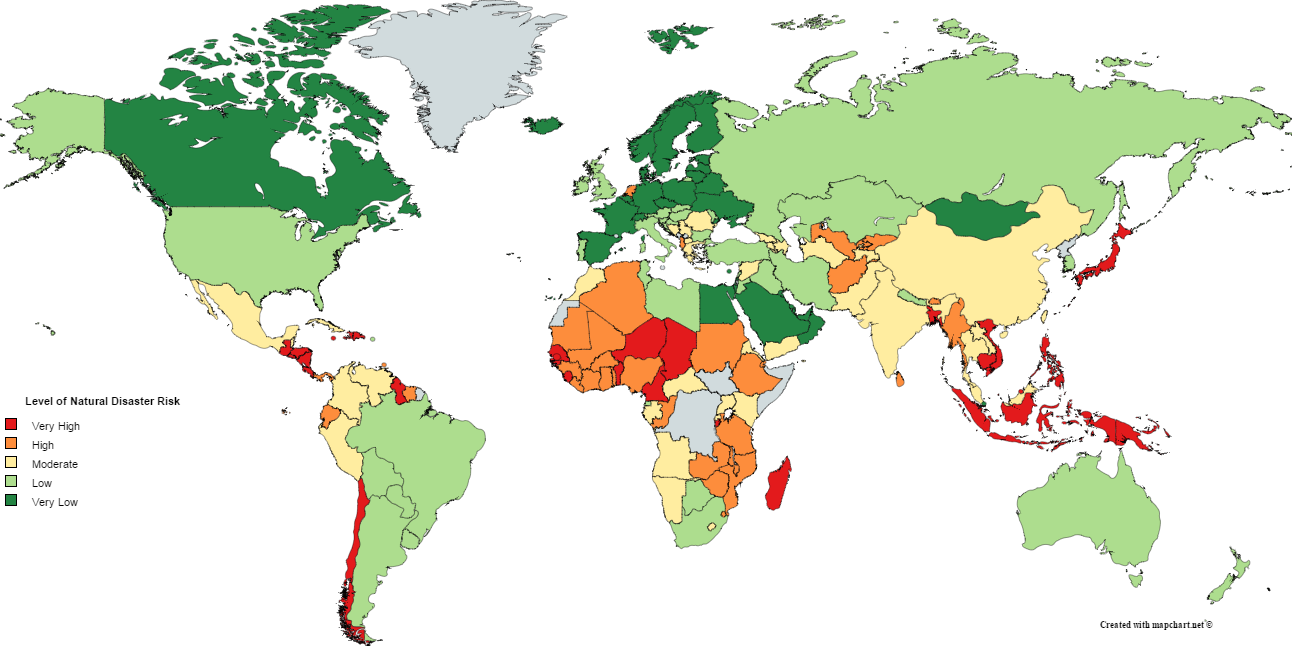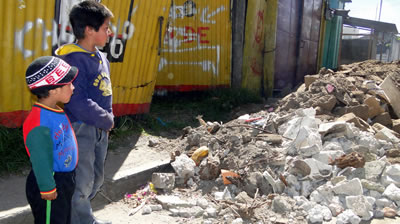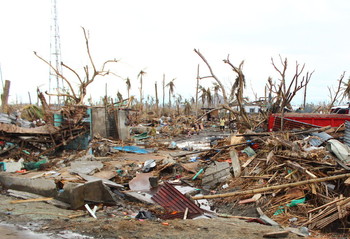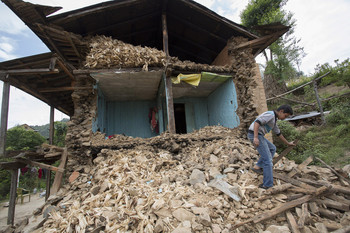Site will be
unavailable for maintenance from June. 4, 11:30 p.m., to June 5, 12:30 a.m. ET. Thank you for your
patience!
The Devastating Impact of Natural Disasters
Posted on 02/06/2013

Based on the United Nations University World Risk Index

Children observe destroyed homes in Guatemala, which suffered a massive earthquake.
(Updated April 6, 2021)
A region’s vulnerability to natural disasters depends on multiple factors. The United Nations University calculates the World Risk Index using four factors: exposure, susceptibility, coping capacities, and adaptive capacities. Exposure is the amount of natural hazards an area is exposed to. Susceptibility refers to the levels of infrastructure, poverty, and nutrition. Coping capacity is the ability to resist the impact of natural disasters through disaster preparedness. Adaptive capacity is the capacity to make structural changes to reduce the impact of natural disasters in the future. When taking into account all these factors, only one is completely out of our control: exposure. The other three factors are all exacerbated by poverty.
Natural Disaster Facts and Statistics
- According to a 2020 report by the United Nations, since 1994, more than 5 billion people have been affected by disasters, which claimed nearly 2 million lives and cost US$2.5 trillion in economic losses.
- Low- and lower-middle-income countries are disproportionately affected by natural disasters. In the same period, 33 percent of countries that experienced disasters were low- to lower-middle income, but 81 percent of people who died in disasters lived in these countries.
- Women and children in developing countries are often the most vulnerable demographic groups after natural disasters.
- 8 out of 10 of the world’s cities most at risk to natural disasters are in the Philippines.
- Natural disasters affect the number of people living below the poverty line, increasing their numbers by more than 50 percent in some cases. The problem is getting worse; up to 325 million extremely poor people are expected to live in the 49 most hazard-prone countries by 2030.
Millions of people are affected by natural disasters every year, and their impact can be calamitous. From the destruction of buildings to the spread of disease, natural disasters can devastate entire countries overnight. Tsunamis, earthquakes and typhoons do not just wreak havoc on land; they also disrupt people's lives in both densely populated cities and remote villages.

Typhoon Haiyan devastated this village on the island of Leyte when it struck the Philippines.
Hazard vs. Disaster
Earthquakes, floods, hurricanes and volcano eruptions are all types of natural hazards, but when do they become natural disasters? The difference is the events’ effects on people. When a typhoon strikes a populated island in the Philippines, destroying homes and lives, it becomes a disaster. People living in poverty are even more vulnerable to natural disasters because they have fewer resources or people to turn to when trying to rebuild their homes and livelihoods.
An Increase in Natural Disasters
According to an October 2020 report from the United Nations, the rate of weather-related disasters (such as cyclones, typhoons and droughts) is growing. Between 2005 and 2014, the annual average of weather-related disasters was 335, an increase of 14 percent from 1995 to 2004 and almost twice the average recorded from 1985 to 1995.
In the past 20 years, 90 percent of major disasters have been caused by 6,457 recorded floods, storms, heat waves, droughts and other weather events. Indonesia, India and the Philippines are among the five countries hit by the highest number of disasters, besides the United States and China.
Why Are Developing Countries More Vulnerable to Natural Disasters?
Developed countries are better prepared to handle the impact of disasters as well as the aftermath. In developing nations, natural disasters trap people in a cycle of poverty because they do not have the resources to rebuild their homes and meet other basic needs, making them less able to recover in the long run. Certain factors present in poverty environments will turn a natural hazard into a disaster:
- Poorly constructed buildings
- Poor sanitation
- Rapid population growth/high density population
- Limited resources for disaster response and rebuilding
- Lack of economic safety nets

A man searches through the wreckage of a home in the Kavrepalanchok district of Nepal after a massive earthquake in April 2015. Photo by Jake Lyell.
Small Island Developing States and Vulnerability to Natural Disasters
Many of the countries most vulnerable to natural disasters are small island developing states (SIDS). These countries experience frequent storms and flooding and have very little resources and man-power to cope. Additionally, the size of these islands means that already fragile economies, usually agriculture-based, can be totally devastated by a natural disaster. With sea levels rapidly rising, SIDS are becoming more vulnerable to natural disasters with little hope for the future.
Human Factors and the Severity of Natural Disasters
There are several human factors that influence the severity of a natural disaster. Even within the same region, different people have different levels of vulnerability to natural hazards.
- Wealth: People living in poverty cannot afford adequate housing or infrastructure. They are unable to acquire resources needed before and after a disaster strikes.
- Education: Education increases awareness about avoiding or reducing the impact of disasters. A better-educated population will have more professionals trained to prepare for catastrophic natural events.
- Governance: Governments can set policies and establish infrastructure to reduce vulnerability to hazards. Some governments have more resources available to dedicate to disaster risk reduction.
- Technology: Technology allows us to forecast weather, significantly reducing vulnerability.
- Age: Children and the elderly are more vulnerable because they have less physical strength and weaker immune systems. Children and the elderly are more dependent on others for survival but may not have anyone to depend upon after disaster strikes.
- Gender: Women are more likely to be poorer and less educated than men, making them more vulnerable to hazards.
The Human Impact of Natural Disasters
Displaced Populations
One of the most immediate effects of natural disasters is population displacement. When countries are ravaged by earthquakes or other powerful forces of nature, many people have to abandon their homes and seek shelter in other regions. A large influx of refugees can disrupt accessibility of health care and education, as well as food supplies and clean water.
Health Risks
Aside from the obvious immediate danger that natural disasters present, the secondary effects can be just as damaging. Temporary camps established to shelter those displaced by these events can increase the spread of COVID-19. Severe flooding can result in stagnant water that allows breeding of waterborne bacteria and malaria-carrying mosquitos. Without emergency relief from international aid organizations and others, death tolls can rise even after the immediate danger has passed.
Food Scarcity
After natural disasters, food often becomes scarce. Thousands of people around the world go hungry as a result of destroyed crops and loss of agricultural supplies, whether it happens suddenly in a storm or gradually in a drought. As a result, food prices rise, reducing families’ purchasing power and increasing the risk of severe malnutrition or worse. The impacts of hunger following an earthquake, typhoon or hurricane can be tremendous, causing lifelong damage to children’s development.
Emotional Aftershocks
Natural disasters can be particularly traumatic for young children. Confronted with scenes of destruction and the deaths of friends and loved ones, many children develop post-traumatic stress disorder (PTSD), a serious psychological condition resulting from extreme trauma. Left untreated, children suffering from PTSD can be prone to lasting psychological damage and emotional distress.
Child-Centered Spaces, or CCSs, help families cope with their new reality following a disaster; they allow parents to seek water, food and shelter while their children are in a safe place with supervision. Also, children can talk about the traumatic things they saw and experienced during the disaster, allowing them to gradually recover. In the Philippines, ChildFund and our local partner organizations were able to start setting up Child-Centered Spaces only four days after Super Typhoon Haiyan struck, affecting nearly 1 million people.
Rebuilding takes all kinds of forms after a disaster strikes a community, but we all can help. Through ChildFund’s Emergency Action Fund, your donation allows us to help communities quickly after disasters occur.
A gift to our Emergency Action Fund today helps provide families with essentials like safe shelter, food and clean water following a catastrophic event. Your support can make an immediate impact!
Loading...


